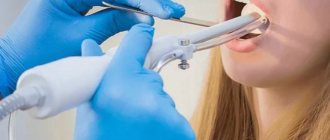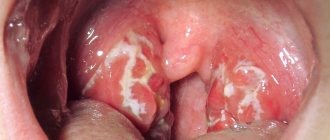Symptoms:
- red, swollen tonsils with white or yellowish coating or streaks;
- a sore throat;
- difficult and/or painful to swallow;
- fever (temperature above 38.0);
- cervical lymph nodes are enlarged;
- hoarse or hoarse voice;
- headache;
- stiff neck muscles;
- abdominal pain (especially in young children).
In infants:
- drooling due to pain in swallowing;
- anxiety;
- refusal to eat
- With chronic tonsillitis, your breath may smell bad.
How is the procedure performed?
All rinsing methods are based on exposing the tonsils to a stream of disinfecting solution or vacuum. Cleaned tonsils are treated with medications.
Processing each tonsil takes from 30 seconds to 1.5 minutes. The time depends on the choice of type of cleaning of the lacunae and the depth of damage to the lacunae.
Important! Before the procedure, you cannot eat for 1.5-2 hours. This is due to the fact that rinsing provokes a gag reflex.
To prevent possible discomfort, the doctor treats the tonsils with a local anesthetic with lidocaine or novocaine in the form of a spray.
Complications of tonsillitis
- Labored breathing.
- Sleep apnea (holding your breath during sleep).
- Spread of infection to the tissue near the tonsils (peritonsillitis), peritonsillar abscess - accumulation of pus behind the tonsil.
- Acute cervical lymphadenitis is inflammation of the cervical lymph nodes.
Streptococcal tonsillitis can cause complications such as:
- acute rheumatic fever, affecting the joints, heart and other organs;
- glomerulonephritis (inflammation of the kidneys, which can lead to serious consequences, including kidney failure).
Treatment with antibiotics significantly reduces the likelihood of complications after streptococcal sore throat.
Contraindications
Treatment of lacunae is not prescribed for patients with:
- exacerbation of other chronic diseases, including caries;
- cancer diagnoses;
- in the 1st and 3rd trimester of pregnancy;
- pathology of the retina;
- severe pathologies of the heart and blood vessels;
- up to 3 years of age.
For hypertension, consultation with a specialized specialist is required.
Important! It is necessary to warn the doctor about any existing individual intolerance to drugs.
Diagnosis of tonsillitis
- For tonsillitis, the doctor will examine the child's throat, as well as his ears and nose, where there may also be inflammation.
- The doctor will examine the child's skin, since streptococcal sore throat sometimes causes a specific rash. This is what is called “scarlet fever” - it is not some kind of separate disease, but a sign of damage to the body by streptococcus.
- The doctor will feel the cervical lymph nodes - as a rule, with tonsillitis they swell.
- The doctor will feel the spleen to distinguish a sore throat from mononucleosis, which also causes swollen lymph nodes.
- The streptococcal test is a simple and accurate way to distinguish streptococcal tonsillitis from viral tonsillitis. The doctor takes a scraping from the child’s throat and within 24-48 hours the result is ready.
- In some cases, a general blood test may be needed, the results of which can also indicate the viral or bacterial nature of the disease. It is usually taken if the streptococcal test is negative, but the course of the disease leaves the doctor in doubt.
About the clinic
Euromed Clinic is a multidisciplinary family clinic in the center of St. Petersburg.
- Calling a doctor to your home
- 24/7 therapist appointment
- Tests, ultrasound, x-ray
- Whole body diagnostics
- Hospital and surgery
- Vaccination
Find out more about the clinic
Washing the tonsils
Due to the structural features of human tonsils, namely the presence of voids, the so-called “lacunae”, as a rule, accumulations of dead epithelial cells, suppuration and bacteria form there. These formations of harmful microorganisms in the cavities of the tonsils can cause inflammation of the mucous membrane. It occurs especially often against the background of reduced immunity and chronic diseases of the nasopharynx. This phenomenon is called tonsillitis.
The procedure for cleansing the tonsils by washing is one of the most common and effective methods of combating tonsillitis and preventing its progression to the chronic stage.
Whatever method of rinsing is chosen, this measure is a guarantee of a quick recovery for a patient suffering from tonsillitis and an effective method of preventing oral diseases in the future.
Vacuum rinsing of tonsils
Washing of the tonsils using the vacuum method is carried out using the Tonzillor apparatus.
Thanks to the advances in hardware of modern medicine, today doctors have a special device that provides high-quality and effective rinsing of the tonsils, eliminating the accumulation of harmful microorganisms, and also has a bactericidal and anti-inflammatory effect.
Washing the tonsils using the vacuum method combines the effect of vacuum on problem areas of the tonsils, as well as the bactericidal effect of a medicinal solution. Such a combination allows for a positive and permanent result in the shortest possible time: reducing the likelihood of chronic oral diseases and eliminating symptoms.
In addition, the procedure has the following positive effects:
- Increased immunity of mucous membranes
- Restoration of microflora on the surface of the tonsils
- Elimination of pathogenic microorganisms and fungus
- Reduces the risk of harmful bacteria growing
- Alleviation of pain syndrome
Washing tonsils using ultrasound
This method is very similar to vacuum rinsing, but there are a number of fundamental differences that make it revolutionary in modern medicine. The procedure is carried out using a special Tonzillor device, developed by Russian specialists. The principle of operation of Tonsillor is reminiscent of an ordinary vacuum cleaner, familiar to everyone: it sucks out all the harmful microorganisms that are in the tonsils and creates a vacuum in the area of the lacunae. However, the Tonsillor device seems more remarkable compared to the vacuum method due to the fact that the tonsils are also washed using ultrasound. Ultrasound cleansing of the tonsils brings a more tangible result from rinsing, effectively affecting all inflammatory processes, anesthetizing problem areas of the throat and promoting deeper penetration of the bactericidal drug into the tissues of the mucous membrane and emptiness of the tonsils.
Washing tonsils at home
Preventive rinsing of the tonsils is also possible at home thanks to a special irrigator device. However, it must be taken into account that the effectiveness of washing the tonsils will be completely different from what the patient visited the clinic for vacuum or ultrasonic washing. However, the device will be useful as a regular preventative measure.
The essence of the principle of operation of the irrigator is that its internal cavity is filled with a medicinal antimicrobial agent. When using an irrigator, a special product is supplied through a tube and a stream, through a special nozzle, is directed directly to the problem areas of the tonsils. The patient can change the jet pressure depending on his sensitivity to ensure more comfortable rinsing. The irrigator is recognized by the medical community as one of the most convenient methods of washing the tonsils at home if there is a need for their constant cleansing.
Treatment of tonsillitis
The child should be provided with:
- peace and the opportunity to sleep as much as he wants;
- Drink plenty of fluids to relieve sore throats and prevent dehydration;
- air humidification;
- a sore throat can be relieved by both warm drinks and cold ice cream, especially popsicles;
- for a sore throat, it helps to gargle with a solution of table salt and soda - a teaspoon of salt and a small pinch of soda per 250 ml of warm water;
- Children over 4 years old can be offered lozenges for sore throats. Do not give candy to small children - they may choke;
- do not smoke when your child is sick, avoid strong odors that irritate the throat;
- A sore throat and fever can be relieved by medications containing paracetamol and ibuprofen. Don't give children aspirin; in rare cases, it can cause deadly Reye's syndrome.
Confirmed bacterial tonsillitis (usually streptococcal tonsillitis) is treated with antibiotics. It is dangerous to interrupt or stop the course because it increases the likelihood of infection spreading to the joints, heart, kidneys and other organs. Continue taking antibiotics even if your symptoms are completely gone.
How to deal with chronic tonsillitis?
How to deal with chronic tonsillitis?
An otolaryngologist of the highest category, director of the onColor medical cryology center, Doctor of Medical Sciences Vladimir Ivanovich KOCHENOV will help you understand this issue.
— Vladimir Ivanovich, if a person often has a sore throat, is this a sign of chronic tonsillitis?
— Chronic tonsillitis is an inflammation of the tonsils, exacerbations of which manifest themselves in the form of sore throats, always with high fever.
People often call any unpleasant sensation in the throat a sore throat, but this is not true. If the temperature is low and the pain is not severe, a person may not take sick leave and suffer from the disease on his feet. Most often, this signal is an exacerbation of pharyngitis.
— Why do the palatine tonsils become inflamed?
— The palatine tonsils are the largest accumulation of lymphoid tissue in the body, which plays an immunological role. Here, new microorganisms, viruses and other foreign agents are “studied”, ways to combat them are found, then this information is “stored” in the palatine tonsils throughout life. Thus, the tonsils are always at the forefront of the fight against infection, which is why they themselves often get sick, especially in young people.
— Can the problem of tonsillitis be solved by removing the tonsils?
— The number of tonsillectomies has decreased sharply compared to even the 70s. After all, the recommendation to remove the tonsils is quite akin to the advice to cut off a finger if you get a splinter.
When comparing groups of young people with and without tonsils removed in childhood, it turned out that those who underwent this intervention were shorter, more susceptible to colds, and less developed physically and even mentally. And adults without tonsils, the organ of immunity, always suffer from the inevitable pharyngitis and more often have cancer.
- How then to treat a sore throat?
- Today, any inflammation in the tonsils can be eliminated using new gentle treatment methods. Among them are cryotherapy, ultrasonic sterilizing cavitation, laser therapy, supplemented by traditional lavage of lacunae.
— Should I use antibiotics?
— Antibiotics cannot eliminate inflammation in the tonsils; this is a path to the development of fungal infection of the pharynx.
Daily and regular rinsing of the throat with decoctions of medicinal herbs, sometimes with the addition of hydrogen peroxide or antiseptics, is necessary.
Dietary supplements normalize the protective functions of the lymphoid tissue of the tonsils; they begin to protect themselves and the entire body from inflammation.
— What is the prevention of tonsillitis?
— Regular (every 3-5 years) preventive use of cryotherapy, a non-surgical treatment with ultra-low temperatures, a kind of local hardening of the throat, allows maintaining the body’s performance at the proper level throughout life.
Love, take care of your tonsils, take care of them and be healthy.
For your information
Sore throats often occur in people with difficulty breathing through their nose. If a person breathes through the mouth, the microbes contained in the air fall directly on the tonsils, the air is not warmed, not moistened and not cleared of dust. Therefore, it is very important to learn to breathe through your nose.
And in cases where this is difficult to achieve, for example, when doing physical work or running in the cold season, you can use a simple technique. To warm the air entering your mouth, you need to press the tip of your tongue against the roof of your mouth. Cold air flowing around the tongue will have time to warm up before it hits the tonsils.
Ekaterina QUEEN.
Vacuum rinsing of tonsils - a fashionable procedure or the last way to avoid surgery?
Practicing ENT doctors believe that a course of washing the tonsils, consisting of at least ten consecutive procedures, can radically improve the patient’s condition, and possibly save him from the need for surgical intervention. The main conditions that ensure the result are the timeliness of the procedures (compensated and subcompensated stage of chronic tonsillitis) and the effectiveness of the technique.
Classical rinsing of the tonsils is carried out using a special syringe with a curved cannula. The spout through which the solution is supplied is directed directly into the “pocket” filled with purulent contents. The disinfectant solution is supplied under pressure and washes the contents out of the gaps. The disadvantage of this method is its potential for trauma to delicate lymphoid tissue and the inability to wash small depressions.
Vacuum rinsing of the tonsils is carried out using a special device, which, in addition to supplying a medicinal solution under high pressure, provides vacuum aspiration of the contents of the lacunae. This allows you to clean “pockets” of any size, and most importantly, it saves you from the need to come into close contact with the tonsil, and therefore does not damage it. In addition to vacuum aspiration, the new technique involves ultrasonic treatment of tissue, which facilitates the rapid removal of plugs of any size and consistency.
Evaluation of the effectiveness of drainage with the “Tonsillor” device
At the end of the course of procedures, bacteriological examination should determine the disappearance or reduction in the number of colonies of pathogenic microorganisms, and a decrease in accumulations of opportunistic microorganisms. Clinically, the positive effect is manifested by the elimination of pain, discomfort in the oropharynx, normalization of the color of the mucous membrane of the palatine tonsils and arches, clearing of lacunae from pathological plaques, reduction in the size of the tonsils, reduction in the severity of regional lymphadenitis, normalization of body temperature and general blood count, and a low probability of relapse of tonsillitis.
Forms of tonsillitis
There are two types of tonsillitis. During the acute form, the disease is infectious in nature, and the tonsils become inflamed. The reason is the bacteria streptococci and staphylococci.
Important: If a person suffers from a sore throat more than once a year, then most likely he has a chronic form of tonsillitis.
Chronic tonsillitis is a long-term and persistent inflammation in the tonsils. It appears after suffering from the flu, low immunity. The disease in chronic form in adults and children occurs in compensated and decompensated forms. In the first case, the disease “sleeps” and worsens infrequently. In the second case, the disease often worsens and complications occur.









